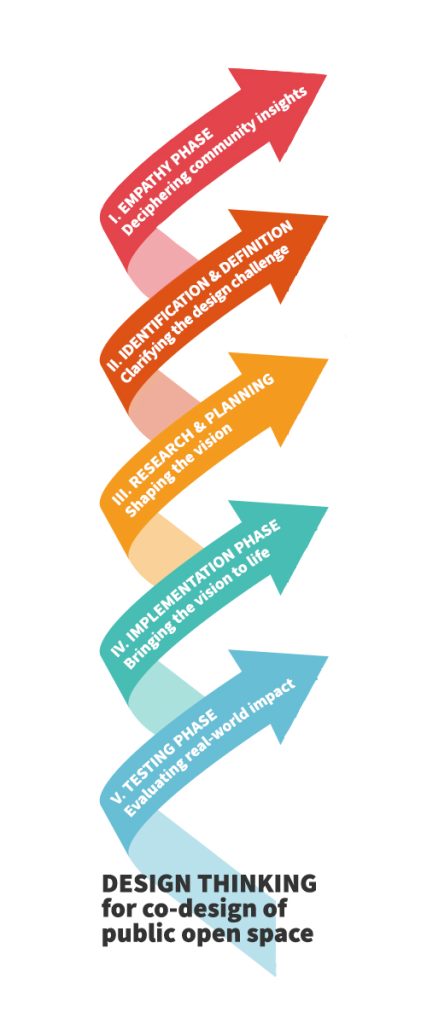Design Thinking dla współprojektowania otwartych przestrzeni publicznych
Praktyczny przewodnik dotyczący stosowania metod Design Thinking w celu podkreślenia zasad projektowania skoncentrowanego na człowieku.
Opis
Design Thinking dla współprojektowania otwartych przestrzeni publicznych
Zestaw narzędzi Design Thinking to praktyczny przewodnik, który ma na celu zapewnienie kompleksowego podejścia, aby pomóc użytkownikom we współprojektowaniu otwartych przestrzeni publicznych. Opiera się on na zasadach Design Thinking i oferuje szereg strategicznych narzędzi i praktycznych kroków mających na celu dostarczenie zintegrowanych rozwiązań poprzez działania obejmujące identyfikację interesariuszy i zrozumienie potrzeb lokalnej społeczności.
Działania te mają na celu opracowanie holistycznego podejścia zakorzenionego w myśleniu projektowym, kładącego nacisk na zasady projektowania zorientowanego na człowieka w celu współprojektowania otwartych przestrzeni publicznych. Podejście to opowiada się za kompleksową oceną potrzeb i aspiracji lokalnej społeczności, obejmującą szereg niekonwencjonalnych narzędzi i strategii sprzyjających generowaniu nowych pomysłów i koncepcji.
Przewodnik Design Thinking prowadzi użytkowników przez dynamiczny proces, który obejmuje pięć głównych faz:
- Faza empatii: Rozszyfrowanie spostrzeżeń społeczności
- Faza identyfikacji i definiowania: Wyjaśnienie wyzwania projektowego
- Faza badań i planowania: Kształtowanie wizji otwartych przestrzeni publicznych
- Faza wdrażania: Wcielanie wizji w życie
Faza testowania: Ocena rzeczywistego wpływu
Zestaw narzędzi Design Thinking zawiera również zestaw najlepszych praktyk, prezentujących trzy wybitne projekty przestrzeni publicznej, które doskonale oddają istotę tego podejścia. Choć nie są one explicite oznaczone jako „Design Thinking”, każdy z nich stanowi świadectwo kluczowych zasad tej metodyki: dogłębnego zrozumienia potrzeb użytkowników, prototypowania rozwiązań oraz ich udoskonalania na podstawie iteracyjnych informacji zwrotnych. Efektem są przestrzenie funkcjonalne, atrakcyjne i tętniące życiem.
Zestaw narzędzi uzupełniono również o przydatne materiały pomocnicze i szablony wspierające różne etapy procesu — takie jak: arkusze planu działania, mapa empatii, siatka przechwytywania informacji zwrotnych, arkusz burzy mózgów, matryca priorytetów czy mapa interesariuszy.
Grupa docelowa
- Doktoranci i młodzi naukowcy pracujący na styku nauk przyrodniczych, urbanistyki i planowania przestrzennego,
- Urbaniści, architekci i inni specjaliści zajmujący się planowaniem przestrzennym i rewitalizacją, ochroną środowiska i urbanistyką, poprawą jakości życia w miastach oraz projektowaniem społecznościowym
- Pracownicy urzędów miejskich i organizacje non-profit zajmujące się poprawą jakości życia w swoich społecznościach.
- Administracja i interesariusze zaangażowani w zbiorowy proces planowania i analizy terytorium
- Małe i średnie przedsiębiorstwa (MŚP) działające na poziomie lokalnym
Korzyści z używania narzędzia
- Wszechstronne i nietradycyjne metody rozwiązywania problemów, które można zastosować w wielu różnych dziedzinach i wyzwaniach.
- Nabycie holistycznych umiejętności identyfikowania i rozwiązywania wyzwań związanych z potrzebami ludzi, stymulowania innowacji i dostosowywania się do różnych scenariuszy rozwiązywania problemów.
- Umożliwienie użytkownikom ułatwiania i optymalizacji procesów współprojektowania w ścisłej współpracy z lokalnymi społecznościami i interesariuszami: działania te mają na celu pozytywną transformację środowiska miejskiego i poprawę jakości życia w miastach.
- Zintegrowana świadomość, że badania i/lub projekty (zagospodarowania przestrzennego) są procesami zbiorowymi.

